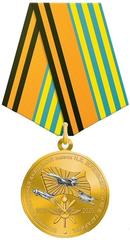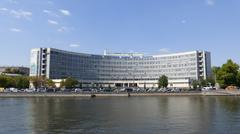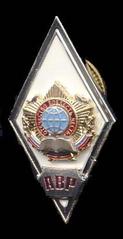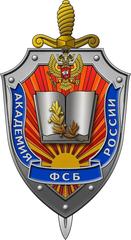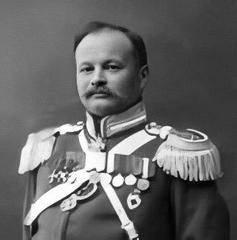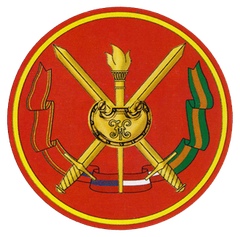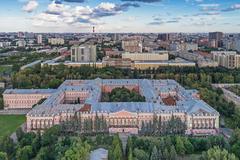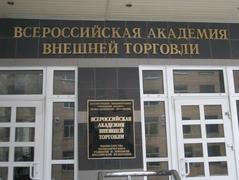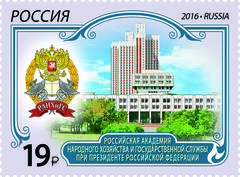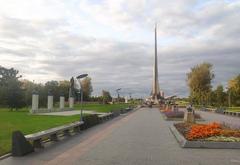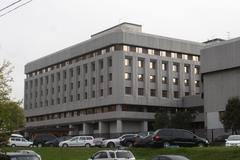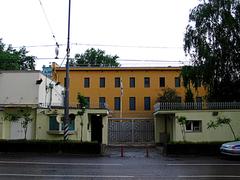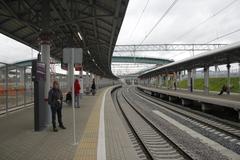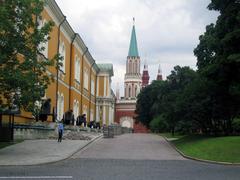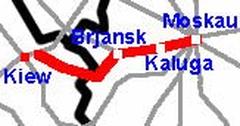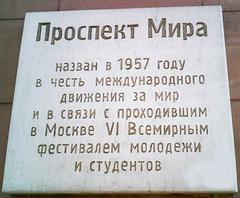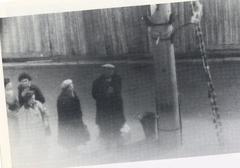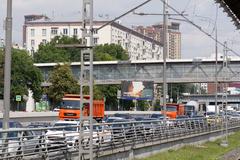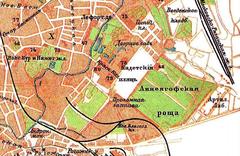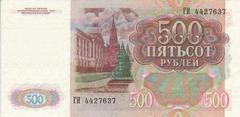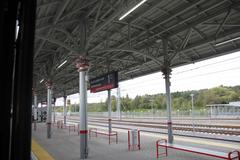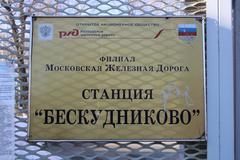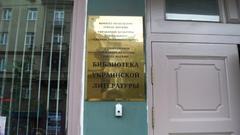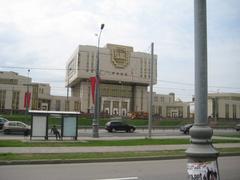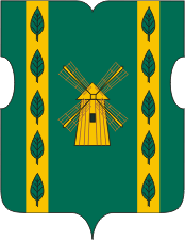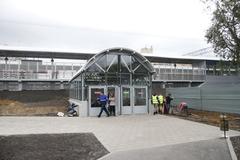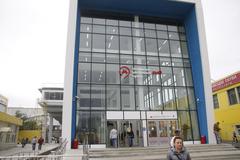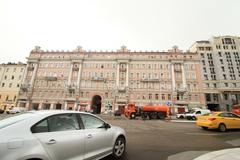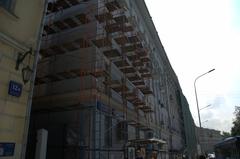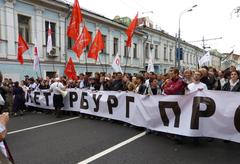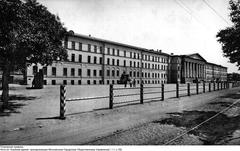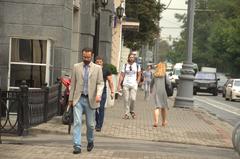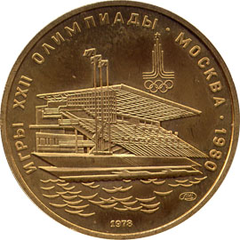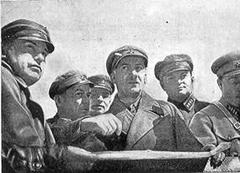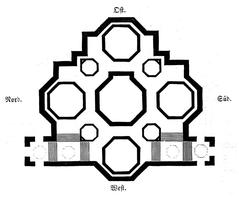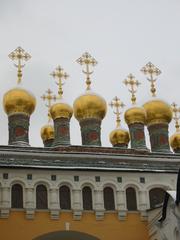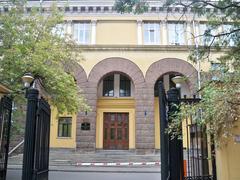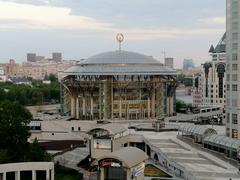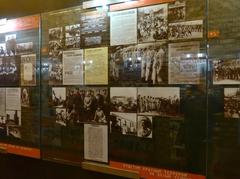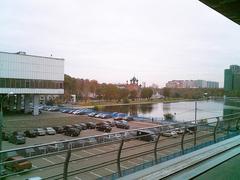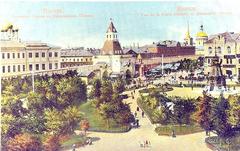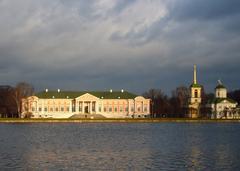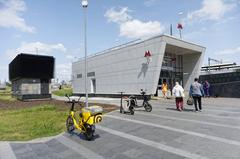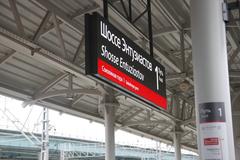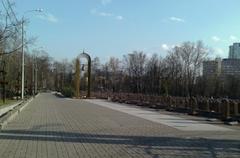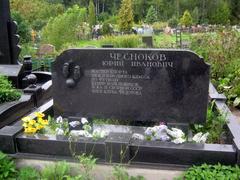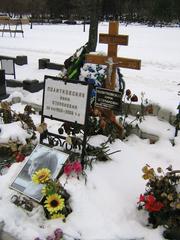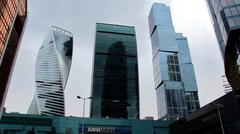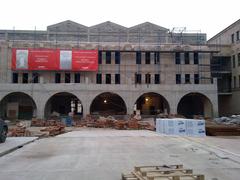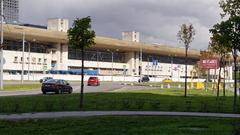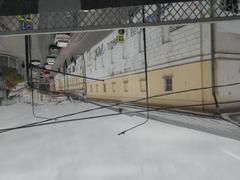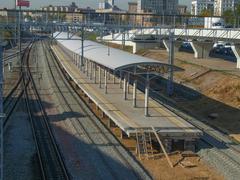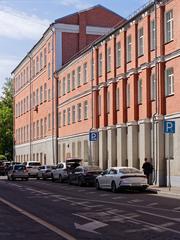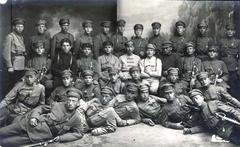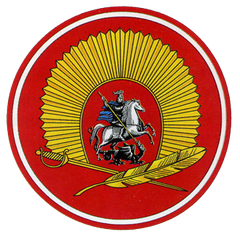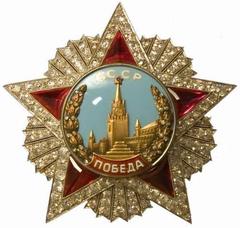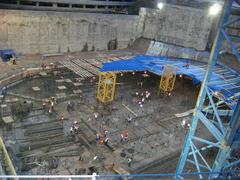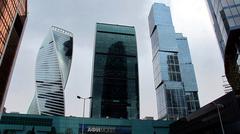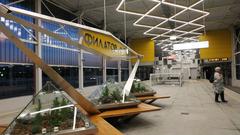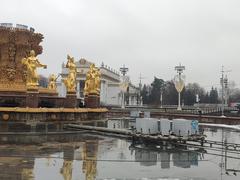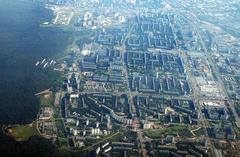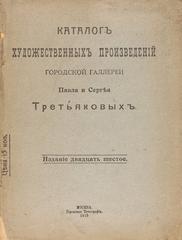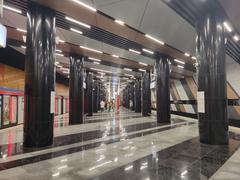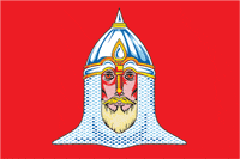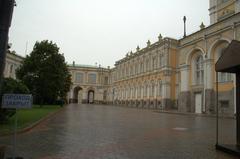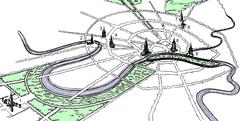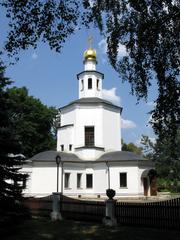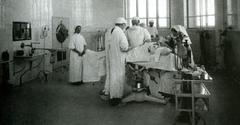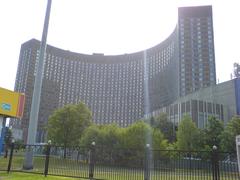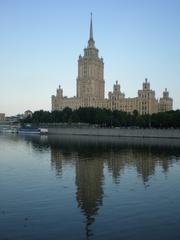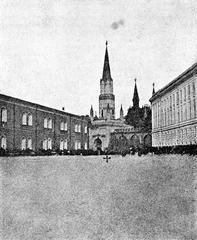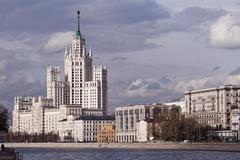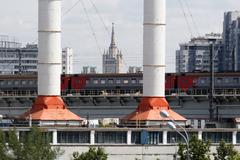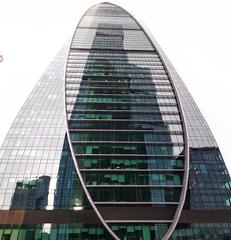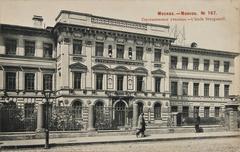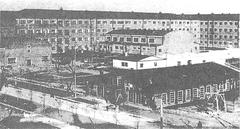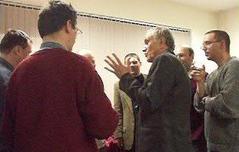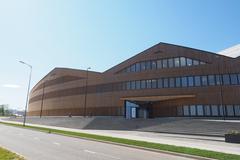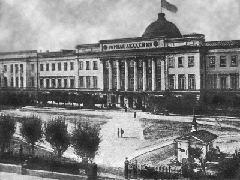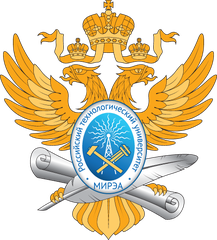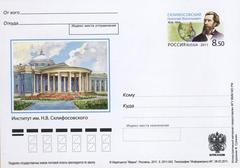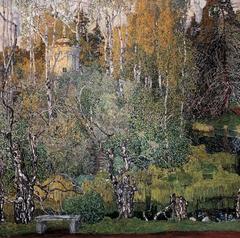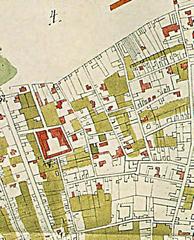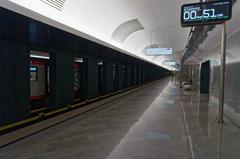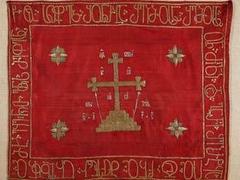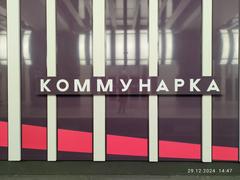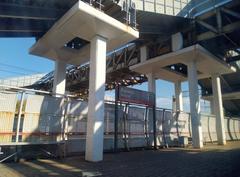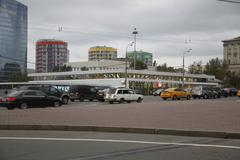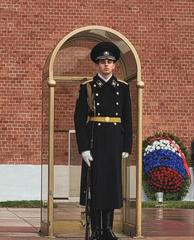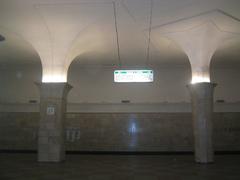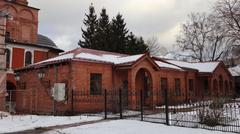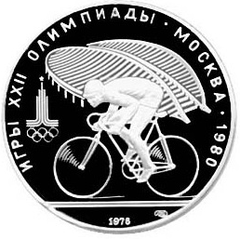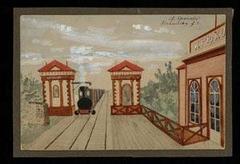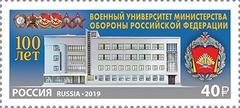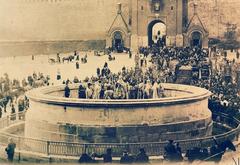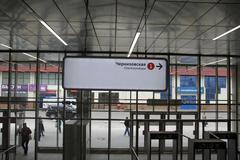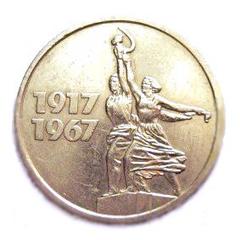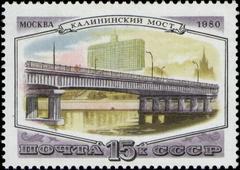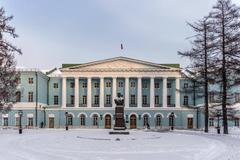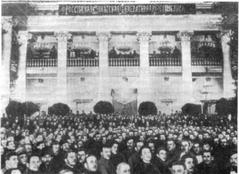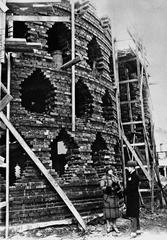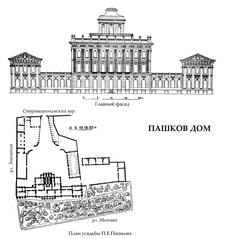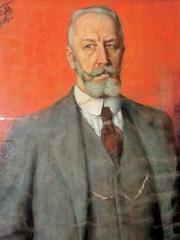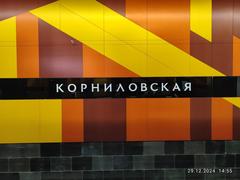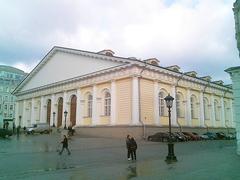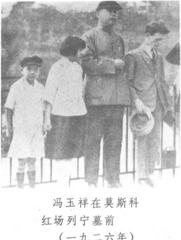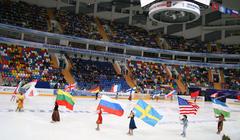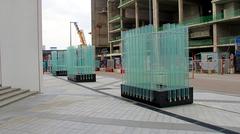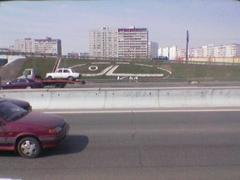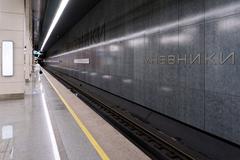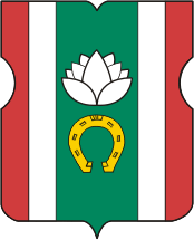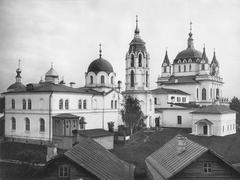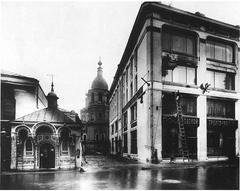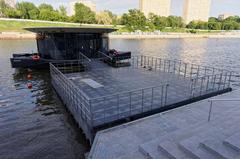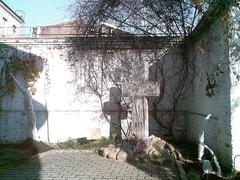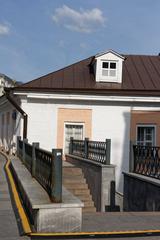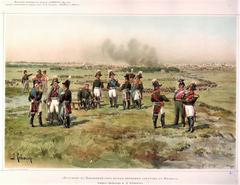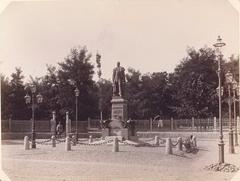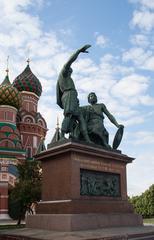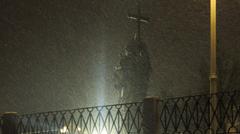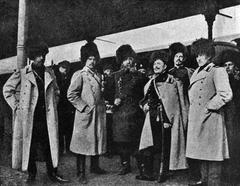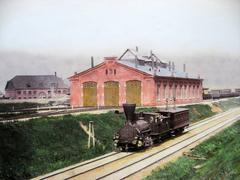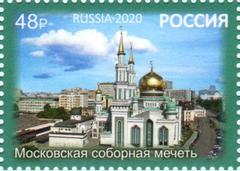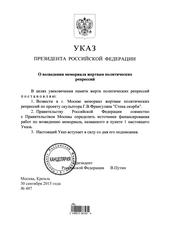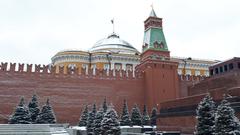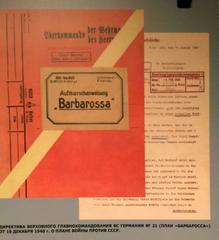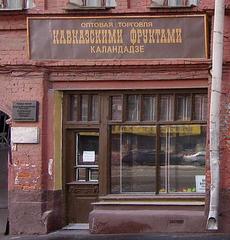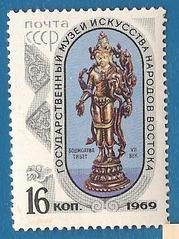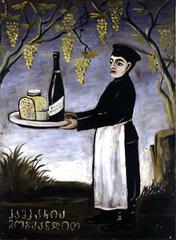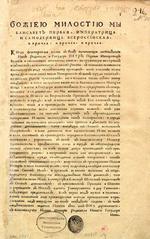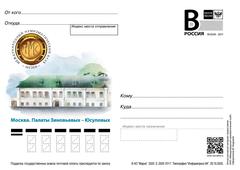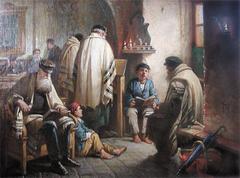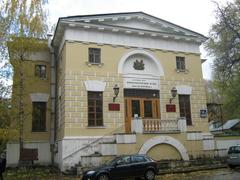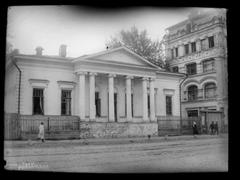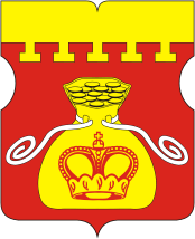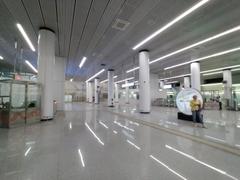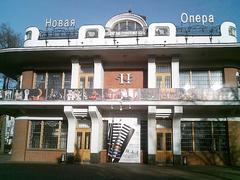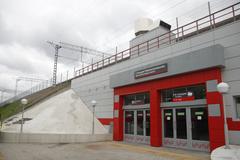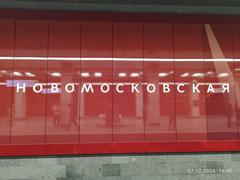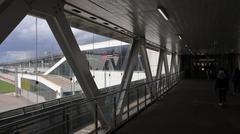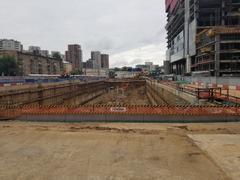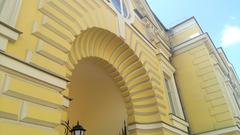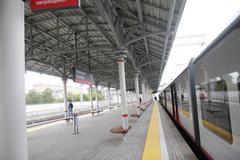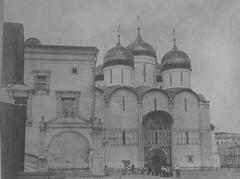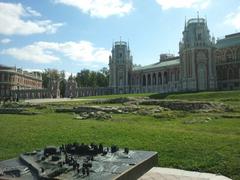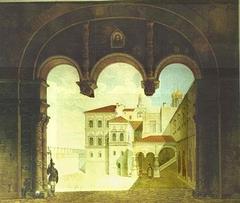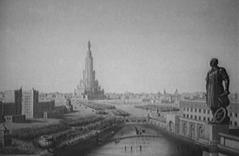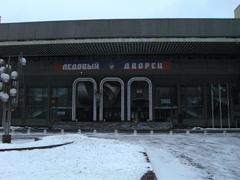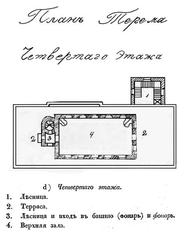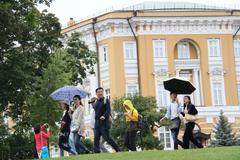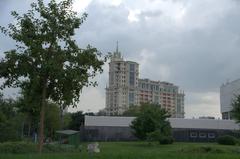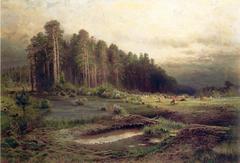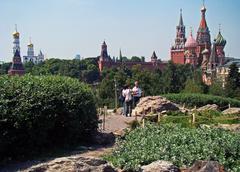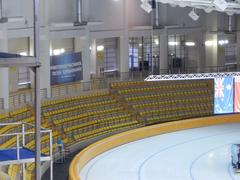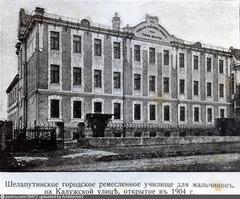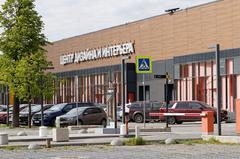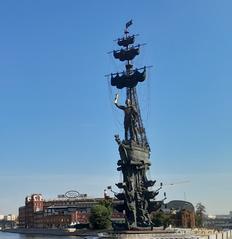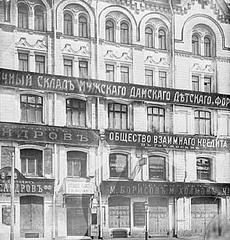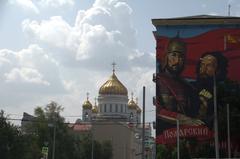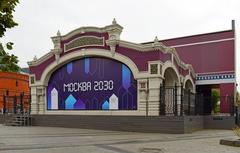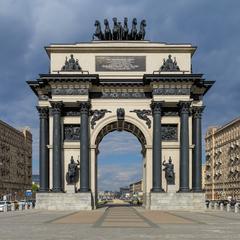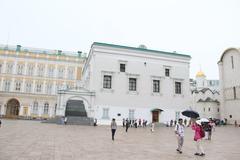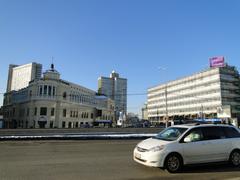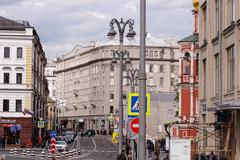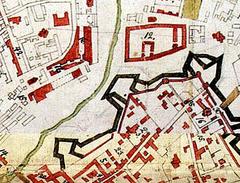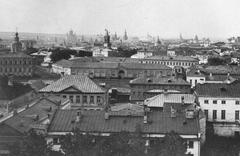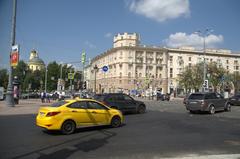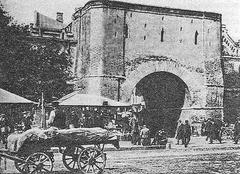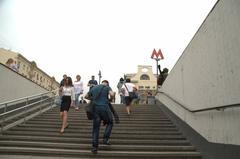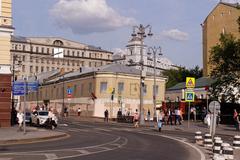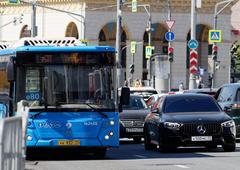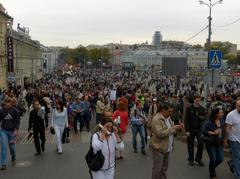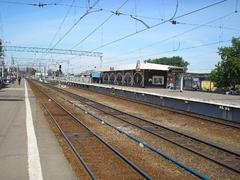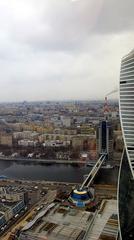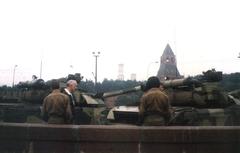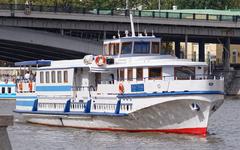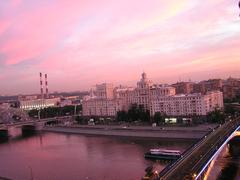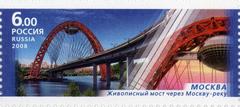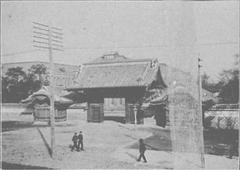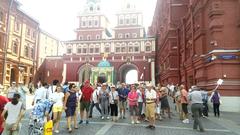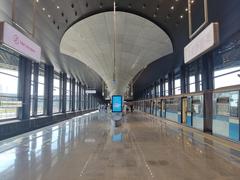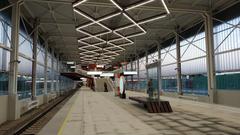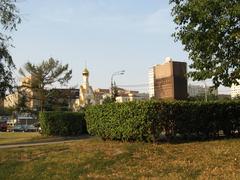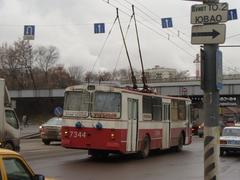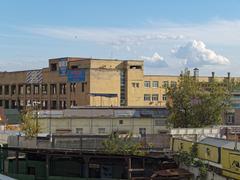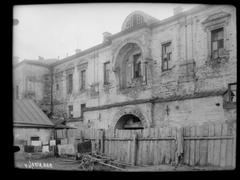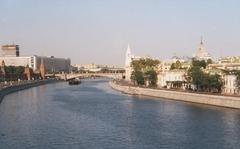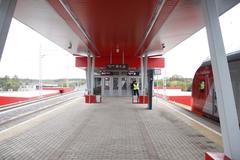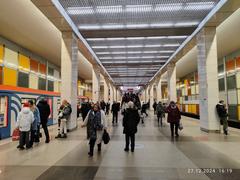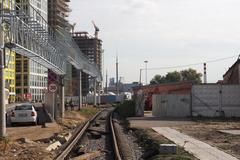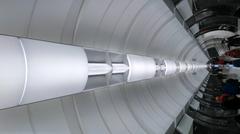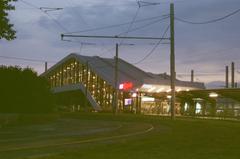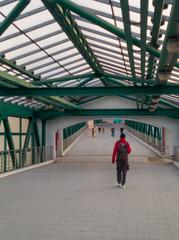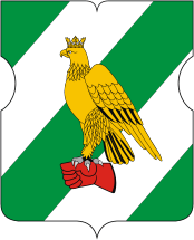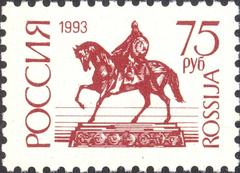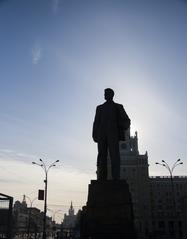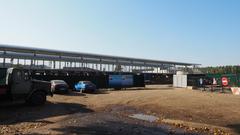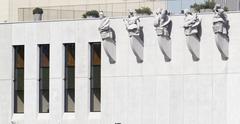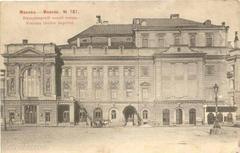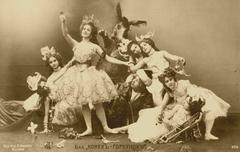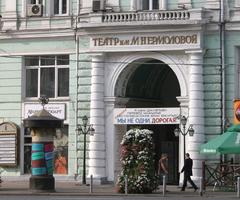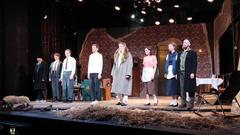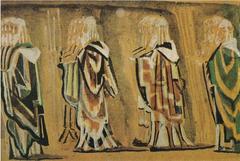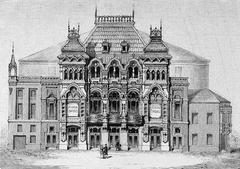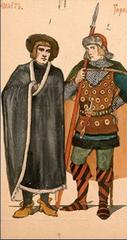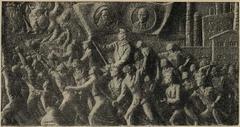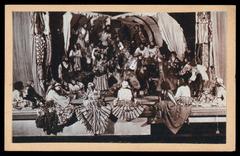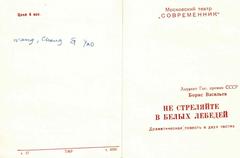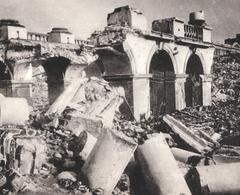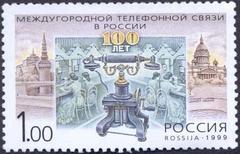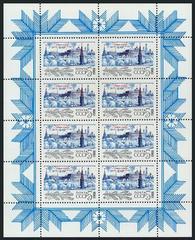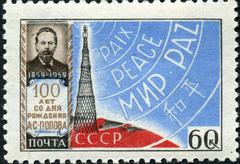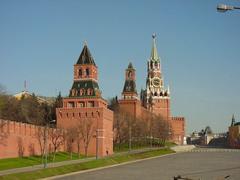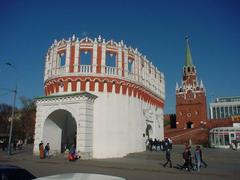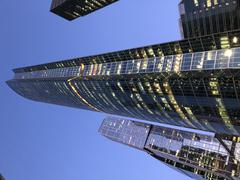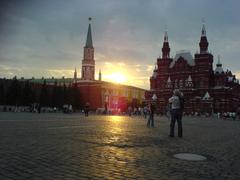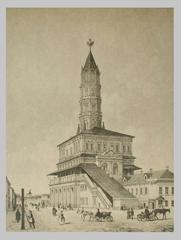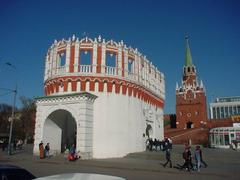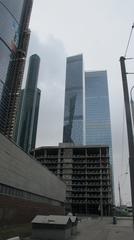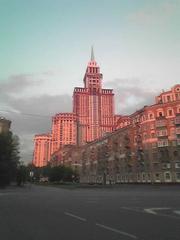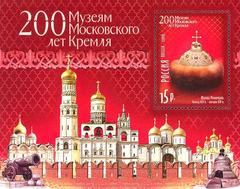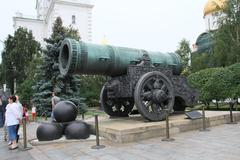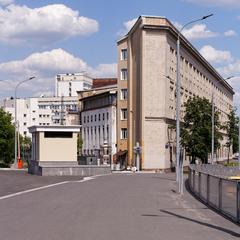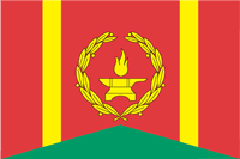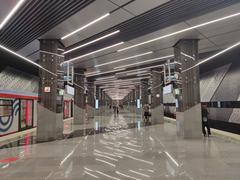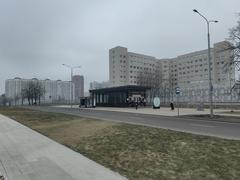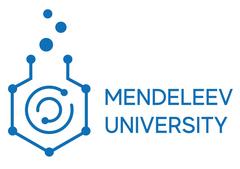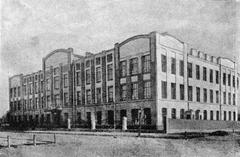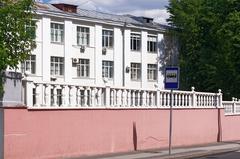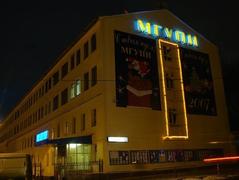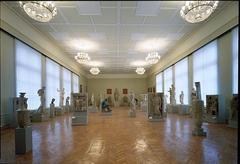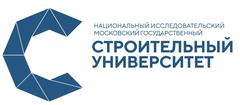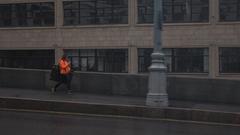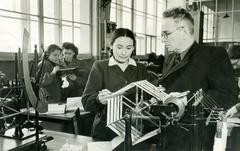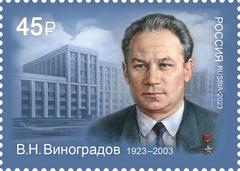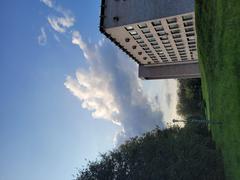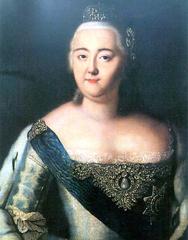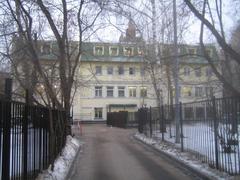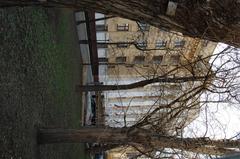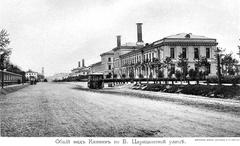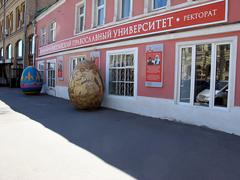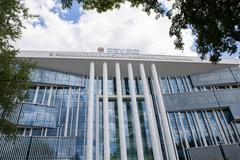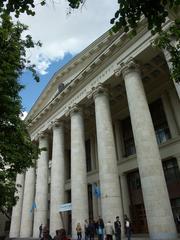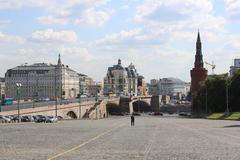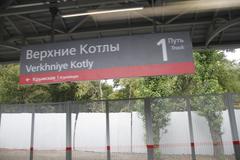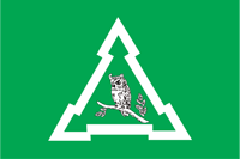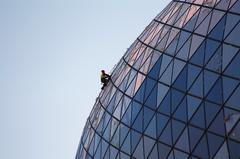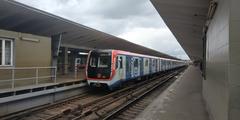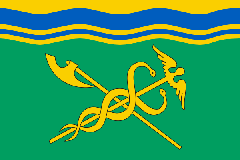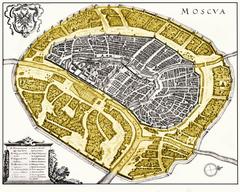Bibliothèque Publique Nationale Russe Pour La Science Et La Technologie
Guide Complet pour la Visite de la Bibliothèque Nationale Russe de Science et Technologie, Moscou, Russie
Date : 14/06/2025
Introduction : La Bibliothèque Nationale Russe de Science et Technologie, un Phare du Savoir
Niché au cœur de Moscou, la Bibliothèque Nationale Russe de Science et Technologie (RNPLS&T) s’affirme comme un monument de l’héritage scientifique et de la signification culturelle. Fondée en 1958 durant l’ère d’avancée scientifique de l’Union soviétique, la RNPLS&T est devenue la plus grande bibliothèque scientifique spécialisée de Russie, avec une collection excédant 15 millions d’articles, incluant livres, périodiques, brevets et documents techniques. La bibliothèque sert non seulement de ressource inestimable pour les chercheurs et les étudiants, mais aussi de monument culturel vivant, favorisant l’engagement du public envers la science et la technologie.
Les visiteurs sont accueillis par son architecture moderniste soviétique emblématique, conçue pour véhiculer l’ouverture et l’accessibilité intellectuelle. L’emplacement central de la bibliothèque, à proximité de pôles académiques et de monuments moscovites comme l’Université d’État de Moscou et le Musée commémoratif de la cosmonautique, la rend facilement accessible via le réseau de transport public efficace de la ville.
Avec une entrée gratuite aux salles de lecture et expositions, la RNPLS&T propose des visites guidées multilingues, des expositions thématiques, des conférences et des ateliers. Son engagement envers l’accessibilité est évident tant dans ses aménagements physiques que dans ses plateformes numériques, garantissant un accueil chaleureux pour tous. Que vous soyez un passionné de science étudiant, ou un explorateur culturel, la bibliothèque offre une expérience unique qui fait le lien entre héritage historique et innovation contemporaine.
Pour les mises à jour les plus récentes, les informations pour les visiteurs et les visites virtuelles immersives, visitez le site officiel de la RNPLS&T (Visiter la Bibliothèque Nationale Russe de Science et Technologie : Horaires, Billets et Importance Historique à Moscou).
Table des Matières
- Introduction
- Horaires de Visite et Informations d’Entrée
- Accessibilité et Services aux Visiteurs
- Comment s’y Rendre et Attractions à Proximité
- Événements Spéciaux, Expositions et Photographie
- Aperçu Historique et Importance Culturelle
- Architecture et Caractéristiques Institutionnelles
- Expérience Visiteur : Installations, Inscription et Conseils
- Engagement Culturel et Inclusivité
- FAQ
- Visuels et Médias
- Ressources Supplémentaires
- Conclusion
Horaires de Visite et Informations d’Entrée
- Horaires d’Ouverture : Du mardi au dimanche, de 10h00 à 19h00. Fermé le lundi et les jours fériés.
- Admission : Entrée gratuite pour tous les visiteurs, incluant l’accès aux salles de lecture et aux expositions. Certains ateliers ou événements spéciaux peuvent nécessiter une inscription préalable ou un droit d’entrée symbolique, dont les détails sont affichés sur le site officiel.
- Inscription : Présentez une pièce d’identité valide (passeport pour les étrangers) à l’entrée pour obtenir une carte visiteur.
Accessibilité et Services aux Visiteurs
La RNPLS&T s’engage pleinement en matière d’accessibilité et d’inclusivité :
- Accessibilité Physique : Le bâtiment est équipé de rampes, d’ascenseurs, de toilettes adaptées et d’une signalisation bilingue (russe/anglais).
- Assistance : Le personnel est formé pour soutenir les visiteurs handicapés et les non-russophones. L’assistance peut être demandée au bureau d’information.
- Visites Guidées : Disponibles en russe et en anglais sur réservation préalable, offrant un aperçu des collections, de l’architecture et de l’histoire de la bibliothèque.
- Accessibilité Numérique : Les plateformes en ligne de la bibliothèque sont conçues pour respecter les normes d’accessibilité internationales, avec des fonctionnalités telles que la compatibilité avec les lecteurs d’écran et des paramètres visuels ajustables.
Comment s’y Rendre et Attractions à Proximité
- Emplacement : 19, rue Oussatchéva, Moscou, 119048, Russie (District de Khamovniki).
- Métro : La station la plus proche est Sportivnaïa (Ligne Rouge), à environ 7 minutes à pied de la bibliothèque.
- Bus/Tramway : Plusieurs lignes desservent la zone.
- Parking : Limité ; les transports publics sont recommandés en raison du trafic et des restrictions de stationnement.
Attractions à Proximité :
- Campus de l’Université d’État de Moscou
- Musée commémoratif de la cosmonautique
- Stade Loujniki
- Parc Gorki
- Monastère de Novodiévitchi (site classé au patrimoine mondial de l’UNESCO)
Combiner une visite à la RNPLS&T avec ces sites rendra votre exploration scientifique et culturelle enrichissante.
Événements Spéciaux, Expositions et Photographie
La RNPLS&T accueille régulièrement :
- Conférences, Ateliers et Expositions Thématiques : Célébrant les réalisations scientifiques russes et internationales. Consultez le calendrier en ligne pour connaître les programmes.
- Photographie : Autorisée dans la plupart des espaces publics. L’utilisation du flash et des trépieds nécessite une approbation préalable de l’administration. Les mosaïques de l’ère soviétique et les salles de lecture sans colonnes de la bibliothèque sont des lieux photographiques privilégiés.
Aperçu Historique et Importance Culturelle
Fondation et Développement
Fondée en 1958, la RNPLS&T a été conçue pour soutenir les initiatives de recherche et d’innovation de l’Union soviétique. Au fil des décennies, elle est devenue la plus grande bibliothèque scientifique de Russie, soutenant les communautés scientifiques nationales et internationales.
Rôle dans la Science et la Culture
La bibliothèque a joué un rôle central pendant l’ère soviétique, offrant aux chercheurs l’accès aux développements scientifiques mondiaux et soutenant des réalisations marquantes telles que le lancement de Spoutnik et les avancées en technologie nucléaire. Aujourd’hui, elle continue de faciliter l’innovation et la culture scientifique par le biais d’expositions, de programmes éducatifs et de ressources numériques.
Caractéristiques Institutionnelles et Collaboration Internationale
Opérant sous le Ministère de la Science et de l’Enseignement Supérieur, la RNPLS&T collabore avec des partenaires mondiaux et participe à des projets internationaux. Ses vastes collections en langues étrangères et sa participation à des initiatives comme la Station Spatiale Internationale et le CERN témoignent de sa contribution continue à l’échange scientifique mondial.
Architecture et Caractéristiques Institutionnelles
Conception et Atmosphère
- Modernisme Soviétique : L’architecture de la bibliothèque, achevée à la fin des années 1960, présente des formes géométriques, de vastes façades vitrées et des intérieurs spacieux conçus pour l’accessibilité et l’ouverture.
- Caractéristiques Notables : Grandes salles de lecture, archives climatisées, rayonnages automatisés et espaces pour conférences et expositions.
- Mises à Jour Récentes : Terminaux numériques, internet haut débit, éclairage moderne et contrôles climatiques économes en énergie.
Expérience Visiteur : Installations, Inscription et Conseils
- Salles de Lecture : Espaces d’étude silencieux, espaces de travail en groupe et salles spécialisées pour les livres rares.
- Ressources Numériques : Accès à des revues électroniques, des bases de données et des livres électroniques ; avec Wi-Fi et terminaux informatiques disponibles.
- Services de Référence : Des bibliothécaires professionnels offrent un soutien à la recherche et une aide au catalogage.
- Cafétéria et Librairie : Les commodités sur place comprennent une petite cafétéria, des distributeurs automatiques et une librairie proposant des publications scientifiques et des souvenirs.
Conseils aux Visiteurs :
- Planifiez à l’avance pour l’accès aux archives ou la participation aux événements.
- Une connaissance de base du russe ou des applications de traduction peut améliorer votre visite.
- Arrivez tôt pour éviter les foules, surtout le week-end.
Sécurité et Sûreté : Des contrôles des sacs et des casiers sont disponibles. Les visiteurs sont priés de maintenir un environnement respectueux et silencieux.
Engagement Culturel et Inclusivité
La RNPLS&T est à l’avant-garde de la promotion de l’inclusivité et de l’engagement culturel :
- Programmation Multiculturelle : Festivals réguliers, événements avec des auteurs et salons du livre internationaux célèbrent la communauté diversifiée de Moscou.
- Collections Inclusives : Ressources dans plus de 30 langues, y compris l’accès à des plateformes numériques mondiales comme PressReader.
- Partenariats Communautaires : La bibliothèque collabore avec des écoles, des groupes de défense et des centres culturels pour élargir l’accès et soutenir les communautés marginalisées.
FAQ
Quels sont les horaires de visite de la RNPLS&T ? Du mardi au dimanche, de 10h00 à 19h00. Fermé les lundis et jours fériés.
L’admission est-elle gratuite ? Oui, l’entrée aux salles de lecture et expositions est gratuite. Certains événements peuvent nécessiter une inscription ou des frais.
Des visites guidées sont-elles disponibles ? Oui, en russe et en anglais, sur réservation préalable.
La bibliothèque est-elle accessible aux personnes handicapées ? Oui, avec des rampes, des ascenseurs, des toilettes accessibles et une assistance du personnel.
Puis-je prendre des photos à l’intérieur ? Oui, dans la plupart des zones publiques. L’utilisation du flash ou du trépied nécessite une permission antérieure.
Comment puis-je m’y rendre en transport en commun ? Prenez le métro de Moscou jusqu’à la station Sportivnaïa (Ligne Rouge) et marchez 7 minutes.
Visuels et Médias
- Visite Virtuelle : Explorez l’architecture et les collections de la bibliothèque en ligne via le site officiel.
- Photographie : Des images de haute qualité et des visites virtuelles offrent un aperçu de la grandeur de la bibliothèque ; le texte alternatif inclut des mots-clés tels que “RNPLS&T Moscou”, “bibliothèque scientifique russe” et “bibliothèque accessible Moscou”.
Ressources Supplémentaires
Conclusion
La Bibliothèque Nationale Russe de Science et Technologie demeure une pierre angulaire du patrimoine scientifique russe, de l’innovation architecturale et de l’inclusivité culturelle. Son admission gratuite, ses installations accessibles et sa programmation dynamique en font une étape incontournable pour quiconque s’intéresse au paysage intellectuel de Moscou. Que vous soyez chercheur, étudiant ou amateur de culture, une visite promet des aperçus de l’engagement de la Russie envers la connaissance et l’innovation.
Planifiez votre visite dès aujourd’hui en consultant le site officiel pour des informations à jour, des visites virtuelles et les programmes d’événements. Pour une assistance personnalisée de voyage, téléchargez l’application Audiala et suivez nos canaux de médias sociaux pour les dernières nouvelles et conseils aux visiteurs.
Références
- Visiter la Bibliothèque Nationale Russe de Science et Technologie : Horaires, Billets et Importance Historique à Moscou, 2025, https://www.gpntb.ru/
- Visiter la Bibliothèque Nationale Russe de Science et Technologie : Horaires, Billets et Guide du Visiteur, 2025, https://www.gpntb.ru/
- Engagement Culturel, Accessibilité et Inclusivité à la Bibliothèque Nationale Russe de Science et Technologie (RNPLS&T) – Guide du Visiteur et Points Forts du Monument, 2025, https://www.gpntb.ru/
Audiala2025Here’s the continuation of the article:
Foundation and Historical Development
Established in 1958, amidst the fervent scientific advancement of the Soviet Union, the RNPLS&T was conceived to bolster national research and innovation. It has since grown to become Russia’s foremost specialized scientific library, housing a vast collection surpassing 15 million items, encompassing books, periodicals, patents, and technical documents from both domestic and international sources.
Role in Soviet and Russian Science
During the Soviet era, the library acted as a crucial conduit for scientific knowledge, granting researchers access to global scientific breakthroughs even amidst the constraints of the Cold War. Its resources were instrumental in supporting landmark achievements, including the pioneering Sputnik launch and advancements in nuclear technology. In the post-Soviet period, the RNPLS&T has adeptly transitioned to the digital age, integrating electronic resources and maintaining its position as a vital research infrastructure.
Significance in Science Policy and Innovation
Currently, the library plays a pivotal role in Russia’s efforts to revitalize its scientific and technological sectors, championing priority research areas and facilitating innovation through access to critical patents and standards essential for technological transfer.
Cultural and Educational Impact
Open to the public, the RNPLS&T actively promotes scientific literacy through engaging exhibitions and educational programs. It serves as a vital bridge connecting the scientific community with the broader public, contributing significantly to Russia’s knowledge-based economy.
Architectural and Institutional Features
Housed within a striking example of Soviet modernist architecture, the library’s design prioritizes accommodating its extensive collections and meeting user needs, featuring capacious reading halls and advanced digitization centers. It operates under the purview of the Ministry of Science and Higher Education and actively engages in collaborations with national and international partners to integrate Russian scientific contributions into the global knowledge ecosystem.
Contribution to International Collaboration
Despite geopolitical complexities, the RNPLS&T actively fosters global scientific exchange through its comprehensive foreign-language collections and its participation in international endeavors such as projects related to the International Space Station and CERN collaborations.
Legacy and Continuing Relevance
Today, the RNPLS&T continues to inspire scientists, students, and visitors alike, embodying the enduring value of knowledge and public service that underpins Russian scientific accomplishment.
Architecture of the Russian National Public Library for Science and Technology
Design Philosophy and Historical Context
The RNPLST, known in Russian as Государственная публичная научно-техническая библиотека России (ГПНТБ России), stands as a symbol of the Soviet Union’s commitment to scientific advancement and widespread education. Inaugurated in 1958, its architectural design embodies the principles of Soviet modernism, emphasizing practicality, user accessibility, and the symbolic importance of knowledge.
Completed towards the end of the 1960s, the primary structure showcases clean lines, geometric forms, and significant use of concrete and glass – materials emblematic of progress and utility. The facade’s imposing, rectilinear design, complemented by expansive windows, invites ample natural light, mirroring the library’s core mission of democratizing access to scientific and technical information.
Internally, visitors will find broad reading halls characterized by high ceilings and modular furnishings, designed to accommodate substantial numbers of users and facilitate collaborative research. The main reading room, notable for its vast, column-free expanse, cultivates an atmosphere of intellectual grandeur and focused study.
Notable Architectural Features
- Main Entrance and Lobby: Features a grand staircase and a minimalist portico leading into a lobby adorned with Soviet-era mosaics and reliefs celebrating science and technology.
- Reading Halls: Specialized spaces equipped with ergonomic seating, ample desk space, and advanced lighting systems tailored to various scientific disciplines.
- Archives and Storage: Houses climate-controlled facilities for rare books and technical documents, incorporating automated shelving systems to enhance retrieval efficiency.
- Conference and Exhibition Spaces: Dedicated areas are available for hosting scientific conferences, lectures, and exhibitions, reinforcing the library’s role as a hub for public engagement with science.
Recent Renovations and Modernization
To adapt to the demands of the digital era, the RNPLS&T has upgraded its facilities, integrating high-speed internet, digital catalog terminals, multimedia workstations, energy-efficient lighting, and advanced climate control systems.
Location and Accessibility
Geographic Setting
Situated centrally within Moscow’s Khamovniki District, the RNPLS&T is conveniently located near major academic institutions and cultural landmarks. The precise address is:
19, ulitsa Usacheva, Moscow, 119048, Russia
This prime location offers easy access to universities, research centers, and public transportation networks.
Transportation and Directions
- Metro Access: The nearest metro station is Sportivnaya (Спортивная) on the Red Line (Line 1), approximately 500 meters away, a short 7-minute walk.
- Bus and Tram: Several bus and tram routes stop within easy walking distance of the library.
- Parking: Limited on-site parking is available. Due to potential traffic congestion and parking restrictions, using public transportation is highly recommended.
Nearby Moscow Historical Sites and Attractions
- Luzhniki Stadium: Located across the Moskva River, this is Russia’s largest sports complex.
- Gorky Park: A popular recreational area featuring tranquil gardens, accessible museums, and pleasant riverside promenades.
- Novodevichy Convent: A UNESCO World Heritage Site, renowned for its exquisite historical architecture and serene atmosphere.
Visitor Experience
Visiting Hours and Ticket Information
- Visiting Hours: The library is open to visitors from Monday to Saturday, 9:00 AM to 8:00 PM. These hours may be subject to change on public holidays or during special events.
- Admission and Tickets: General admission to the library is free for most visitors. Registration at the entrance, requiring a valid ID, is necessary to obtain a library card. Certain specialized services, access to archives, or participation in specific events might incur a nominal fee or require prior booking.
Entry and Registration
Upon arrival, visitors are required to register. A valid identification document (e.g., passport for international visitors) must be presented to receive either a temporary or permanent access card, depending on the intended use.
Facilities and Services
- Reading Rooms: The library offers quiet study areas, collaborative workspaces for groups, and specialized rooms dedicated to the preservation and study of rare books.
- Digital Resources: Visitors can access an extensive digital library, including a wide array of journals, databases, and e-books. Computer terminals and Wi-Fi connectivity are readily available.
- Reference Assistance: Professional librarians are on hand to provide research support, guidance on navigating the library’s catalog, and interlibrary loan services.
- Exhibitions and Events: The library regularly hosts exhibitions, lectures, and workshops focusing on science, technology, and library science. Advance booking may be necessary for certain events.
Accessibility and Inclusivity
The library is committed to inclusivity, providing accessible facilities such as ramps, elevators, and adaptable restrooms. Bilingual signage (Russian and English) is present throughout the building, and staff are trained to assist visitors with disabilities and those who do not speak Russian fluently.
Photography and Unique Features
Photography is generally permitted in public areas, though it is restricted in reading rooms and archives. Visitors are advised to confirm with library staff before taking photographs. The library’s decorative mosaics, historical reliefs, and the distinctive column-free reading halls are popular subjects for photography.
Visitor Tips
- Plan Ahead: It’s advisable to contact the library in advance if you wish to access special archives or participate in specific events.
- Language: While most resources are in Russian, having some basic knowledge of the Cyrillic alphabet or using translation applications can significantly enhance your visit.
- Amenities: Convenient amenities such as a small cafeteria, vending machines, and comfortable lounges are available for visitors.
Safety and Security
Standard security measures are in place, including bag checks at the entrance and lockers for personal belongings. Visitors are expected to maintain a quiet and respectful environment within the library premises.
Souvenirs and Bookshop
A bookshop located near the entrance offers a selection of scientific publications and library-themed souvenirs, making them ideal gifts or mementos of your visit.
Cultural Engagement, Accessibility, and Inclusivity
Visitor Information: Hours, Tickets, and Access
- Visiting Hours: The RNPLS&T welcomes visitors from 10:00 AM to 8:00 PM, Monday through Saturday. The library is closed on Sundays and major public holidays.
- Ticket Information: General admission to the library building and its permanent exhibitions is free of charge. However, some special events and workshops may require advance registration or a nominal fee.
- Guided Tours: Tours are offered in Russian and English and can be arranged by appointment. These tours provide valuable insights into the library’s architecture, history, and cultural programs.
- Location: Situated in the heart of Moscow, the library is easily accessible via public transportation, with the Kitay-Gorod metro station being the closest.
Cultural Engagement and Programming
The RNPLS&T actively promotes cultural engagement through its diverse multicultural programming and community outreach initiatives. Events frequently include cultural festivals, author readings, panel discussions, and international book fairs designed to celebrate the contributions of various ethnic groups. Workshops focusing on diversity, cultural sensitivity, and inclusivity aim to deepen visitors’ understanding and foster dialogue within Moscow’s cosmopolitan community.
Inclusive Collections and Multilingual Resources
As a monument to knowledge, the library boasts collections in over 30 languages, encompassing scientific literature, fiction, periodicals, and digital resources. Its digital platforms, such as PressReader, offer access to publications from more than 120 countries in over 60 languages, ensuring equitable access to information for all patrons.
Accessibility: Physical and Digital
- Physical Accessibility: The library is equipped with ramps, elevators, accessible restrooms, clear bilingual signage (Russian and English), assistive listening devices, and sensory-friendly spaces. Sign language interpretation is available for select events.
- Digital Accessibility: The RNPLS&T website and its online catalog adhere to international accessibility standards, providing features such as adjustable fonts, high-contrast modes, and compatibility with screen readers. Remote access to e-books and databases ensures that users with disabilities or mobility limitations can explore resources from any location.
Nearby Attractions and Travel Tips
- Nearby Attractions: While visiting the RNPLS&T, consider exploring other historical sites such as Red Square, the Kremlin, and the historic Kitay-Gorod district.
- Travel Tips: It is recommended to visit early in the day to avoid crowds, particularly on weekends. Photography is permitted in most public areas, offering excellent opportunities to capture the library’s architectural beauty and cultural exhibits.
- Getting There: The most convenient way to reach the library is via the Kitay-Gorod metro station. Parking facilities are limited, so public transportation or taxis are the advised options.
Cultural Exhibits, Storytelling, and Special Events
The RNPLS&T curates exhibitions that highlight the rich history, art, and scientific achievements of various communities. Storytelling sessions, including global folktales and interactive “living library” events, enhance the visitor experience and promote intercultural understanding.
FAQ: Your Visit to the RNPLS&T
Q: Do I need to book tickets in advance? A: No ticket is required for general admission, but pre-registration is recommended for popular workshops and tours.
Q: Is the library suitable for children? A: Yes, with storytelling sessions and interactive workshops designed for all ages.
Q: Are there facilities for visitors with disabilities? A: Yes, the library is fully accessible and offers specialized services.
Q: What languages are supported onsite? A: Services and materials are available in Russian, English, and over 30 other languages.
Visual and Interactive Resources
Visitors can enjoy high-quality photographs and virtual tours available on the official website, offering a preview of the monument’s grandeur and cultural offerings. Alt text for images includes keywords such as “RNPLS&T Moscow monument,” “Russian National Library cultural exhibits,” and “accessible library in Moscow.”
Partnerships and Community Collaboration
The RNPLS&T actively collaborates with schools, cultural centers, and advocacy groups to broaden its reach and enhance inclusivity, with a particular focus on supporting immigrants, refugees, and individuals with disabilities.
Conclusion: Experience the RNPLS&T Monument – A Hub of Culture and Accessibility
Whether you are a history enthusiast, a cultural explorer, or a student of science, the Russian National Public Library for Science and Technology offers a unique monument experience, harmonizing heritage, inclusivity, and modern accessibility. Plan your visit today to immerse yourself in Moscow’s vibrant cultural tapestry.
Plan Your Visit: For updated event schedules, guided tour bookings, and access to digital resources, visit the official RNPLS&T website at https://www.gpntb.ru/.
Stay Connected: Follow our social media channels for the latest news, virtual tours, and community stories.
Audiala2025### Foundation and Historical Development
Established in 1958, amidst the fervent scientific advancement of the Soviet Union, the RNPLS&T was conceived to bolster national research and innovation. It has since grown to become Russia’s foremost specialized scientific library, housing a vast collection surpassing 15 million items, encompassing books, periodicals, patents, and technical documents from both domestic and international sources.
Role in Soviet and Russian Science
During the Soviet era, the library acted as a crucial conduit for scientific knowledge, granting researchers access to global scientific breakthroughs even amidst the constraints of the Cold War. Its resources were instrumental in supporting landmark achievements, including the pioneering Sputnik launch and advancements in nuclear technology. In the post-Soviet period, the RNPLS&T has adeptly transitioned to the digital age, integrating electronic resources and maintaining its position as a vital research infrastructure.
Significance in Science Policy and Innovation
Currently, the library plays a pivotal role in Russia’s efforts to revitalize its scientific and technological sectors, championing priority research areas and facilitating innovation through access to critical patents and standards essential for technological transfer.
Cultural and Educational Impact
Open to the public, the RNPLS&T actively promotes scientific literacy through engaging exhibitions and educational programs. It serves as a vital bridge connecting the scientific community with the broader public, contributing significantly to Russia’s knowledge-based economy.
Architectural and Institutional Features
Housed within a striking example of Soviet modernist architecture, the library’s design prioritizes accommodating its extensive collections and meeting user needs, featuring capacious reading halls and advanced digitization centers. It operates under the purview of the Ministry of Science and Higher Education and actively engages in collaborations with national and international partners to integrate Russian scientific contributions into the global knowledge ecosystem.
Contribution to International Collaboration
Despite geopolitical complexities, the RNPLS&T actively fosters global scientific exchange through its comprehensive foreign-language collections and its participation in international endeavors such as projects related to the International Space Station and CERN collaborations.
Legacy and Continuing Relevance
Today, the RNPLS&T continues to inspire scientists, students, and visitors alike, embodying the enduring value of knowledge and public service that underpins Russian scientific accomplishment.
Architecture of the Russian National Public Library for Science and Technology
Design Philosophy and Historical Context
The RNPLST, known in Russian as Государственная публичная научно-техническая библиотека России (ГПНТБ России), stands as a symbol of the Soviet Union’s commitment to scientific advancement and widespread education. Inaugurated in 1958, its architectural design embodies the principles of Soviet modernism, emphasizing practicality, user accessibility, and the symbolic importance of knowledge.
Completed towards the end of the 1960s, the primary structure showcases clean lines, geometric forms, and significant use of concrete and glass – materials emblematic of progress and utility. The facade’s imposing, rectilinear design, complemented by expansive windows, invites ample natural light, mirroring the library’s core mission of democratizing access to scientific and technical information.
Internally, visitors will find broad reading halls characterized by high ceilings and modular furnishings, designed to accommodate substantial numbers of users and facilitate collaborative research. The main reading room, notable for its vast, column-free expanse, cultivates an atmosphere of intellectual grandeur and focused study.
Notable Architectural Features
- Main Entrance and Lobby: Features a grand staircase and a minimalist portico leading into a lobby adorned with Soviet-era mosaics and reliefs celebrating science and technology.
- Reading Halls: Specialized spaces equipped with ergonomic seating, ample desk space, and advanced lighting systems tailored to various scientific disciplines.
- Archives and Storage: Houses climate-controlled facilities for rare books and technical documents, incorporating automated shelving systems to enhance retrieval efficiency.
- Conference and Exhibition Spaces: Dedicated areas are available for hosting scientific conferences, lectures, and exhibitions, reinforcing the library’s role as a hub for public engagement with science.
Recent Renovations and Modernization
To adapt to the demands of the digital era, the RNPLS&T has upgraded its facilities, integrating high-speed internet, digital catalog terminals, multimedia workstations, energy-efficient lighting, and advanced climate control systems.
Location and Accessibility
Geographic Setting
Situated centrally within Moscow’s Khamovniki District, the RNPLS&T is conveniently located near major academic institutions and cultural landmarks. The precise address is:
19, ulitsa Usacheva, Moscow, 119048, Russia
This prime location offers easy access to universities, research centers, and public transportation networks.
Transportation and Directions
- Metro Access: The nearest metro station is Sportivnaya (Спортивная) on the Red Line (Line 1), approximately 500 meters away, a short 7-minute walk.
- Bus and Tram: Several bus and tram routes stop within easy walking distance of the library.
- Parking: Limited on-site parking is available. Due to potential traffic congestion and parking restrictions, using public transportation is highly recommended.
Nearby Moscow Historical Sites and Attractions
- Luzhniki Stadium: Located across the Moskva River, this is Russia’s largest sports complex.
- Gorky Park: A popular recreational area featuring tranquil gardens, accessible museums, and pleasant riverside promenades.
- Novodevichy Convent: A UNESCO World Heritage Site, renowned for its exquisite historical architecture and serene atmosphere.
Visitor Experience
Visiting Hours and Ticket Information
- Visiting Hours: The library is open to visitors from Monday to Saturday, 9:00 AM to 8:00 PM. These hours may be subject to change on public holidays or during special events.
- Admission and Tickets: General admission to the library is free for most visitors. Registration at the entrance, requiring a valid ID, is necessary to obtain a library card. Certain specialized services, access to archives, or participation in specific events might incur a nominal fee or require prior booking.
Entry and Registration
Upon arrival, visitors are required to register. A valid identification document (e.g., passport for international visitors) must be presented to receive either a temporary or permanent access card, depending on the intended use.
Facilities and Services
- Reading Rooms: The library offers quiet study areas, collaborative workspaces for groups, and specialized rooms dedicated to the preservation and study of rare books.
- Digital Resources: Visitors can access an extensive digital library, including a wide array of journals, databases, and e-books. Computer terminals and Wi-Fi connectivity are readily available.
- Reference Assistance: Professional librarians are on hand to provide research support, guidance on navigating the library’s catalog, and interlibrary loan services.
- Exhibitions and Events: The library regularly hosts exhibitions, lectures, and workshops focusing on science, technology, and library science. Advance booking may be necessary for certain events.
Accessibility and Inclusivity
The library is committed to inclusivity, providing accessible facilities such as ramps, elevators, and adaptable restrooms. Bilingual signage (Russian and English) is present throughout the building, and staff are trained to assist visitors with disabilities and those who do not speak Russian fluently.
Photography and Unique Features
Photography is generally permitted in public areas, though it is restricted in reading rooms and archives. Visitors are advised to confirm with library staff before taking photographs. The library’s decorative mosaics, historical reliefs, and the distinctive column-free reading halls are popular subjects for photography.
Visitor Tips
- Plan Ahead: It’s advisable to contact the library in advance if you wish to access special archives or participate in specific events.
- Language: While most resources are in Russian, having some basic knowledge of the Cyrillic alphabet or using translation applications can significantly enhance your visit.
- Amenities: Convenient amenities such as a small cafeteria, vending machines, and comfortable lounges are available for visitors.
Safety and Security
Standard security measures are in place, including bag checks at the entrance and lockers for personal belongings. Visitors are expected to maintain a quiet and respectful environment within the library premises.
Souvenirs and Bookshop
A bookshop located near the entrance offers a selection of scientific publications and library-themed souvenirs, making them ideal gifts or mementos of your visit.
Cultural Engagement, Accessibility, and Inclusivity
Visitor Information: Hours, Tickets, and Access
- Visiting Hours: The RNPLS&T welcomes visitors from 10:00 AM to 8:00 PM, Monday through Saturday. The library is closed on Sundays and major public holidays.
- Ticket Information: General admission to the library building and its permanent exhibitions is free of charge. However, some special events and workshops may require advance registration or a nominal fee.
- Guided Tours: Tours are offered in Russian and English and can be arranged by appointment. These tours provide valuable insights into the library’s architecture, history, and cultural programs.
- Location: Situated in the heart of Moscow, the library is easily accessible via public transportation, with the Kitay-Gorod metro station being the closest.
Cultural Engagement and Programming
The RNPLS&T actively promotes cultural engagement through its diverse multicultural programming and community outreach initiatives. Events frequently include cultural festivals, author readings, panel discussions, and international book fairs designed to celebrate the contributions of various ethnic groups. Workshops focusing on diversity, cultural sensitivity, and inclusivity aim to deepen visitors’ understanding and foster dialogue within Moscow’s cosmopolitan community.
Inclusive Collections and Multilingual Resources
As a monument to knowledge, the library boasts collections in over 30 languages, encompassing scientific literature, fiction, periodicals, and digital resources. Its digital platforms, such as PressReader, offer access to publications from more than 120 countries in over 60 languages, ensuring equitable access to information for all patrons.
Accessibility: Physical and Digital
- Physical Accessibility: The library is equipped with ramps, elevators, accessible restrooms, clear bilingual signage (Russian and English), assistive listening devices, and sensory-friendly spaces. Sign language interpretation is available for select events.
- Digital Accessibility: The RNPLS&T website and its online catalog adhere to international accessibility standards, providing features such as adjustable fonts, high-contrast modes, and compatibility with screen readers. Remote access to e-books and databases ensures that users with disabilities or mobility limitations can explore resources from any location.
Nearby Attractions and Travel Tips
- Nearby Attractions: While visiting the RNPLS&T, consider exploring other historical sites such as Red Square, the Kremlin, and the historic Kitay-Gorod district.
- Travel Tips: It is recommended to visit early in the day to avoid crowds, particularly on weekends. Photography is permitted in most public areas, offering excellent opportunities to capture the library’s architectural beauty and cultural exhibits.
- Getting There: The most convenient way to reach the library is via the Kitay-Gorod metro station. Parking facilities are limited, so public transportation or taxis are the advised options.
Cultural Exhibits, Storytelling, and Special Events
The RNPLS&T curates exhibitions that highlight the rich history, art, and scientific achievements of various communities. Storytelling sessions, including global folktales and interactive “living library” events, enhance the visitor experience and promote intercultural understanding.
FAQ: Your Visit to the RNPLS&T
Q: Do I need to book tickets in advance? A: No ticket is required for general admission, but pre-registration is recommended for popular workshops and tours.
Q: Is the library suitable for children? A: Yes, with storytelling sessions and interactive workshops designed for all ages.
Q: Are there facilities for visitors with disabilities? A: Yes, the library is fully accessible and offers specialized services.
Q: What languages are supported onsite? A: Services and materials are available in Russian, English, and over 30 other languages.
Visual and Interactive Resources
Visitors can enjoy high-quality photographs and virtual tours available on the official website, offering a preview of the monument’s grandeur and cultural offerings. Alt text for images includes keywords such as “RNPLS&T Moscow monument,” “Russian National Library cultural exhibits,” and “accessible library in Moscow.”
Partnerships and Community Collaboration
The RNPLS&T actively collaborates with schools, cultural centers, and advocacy groups to broaden its reach and enhance inclusivity, with a particular focus on supporting immigrants, refugees, and individuals with disabilities.
Conclusion: Experience the RNPLS&T Monument – A Hub of Culture and Accessibility
Whether you are a history enthusiast, a cultural explorer, or a student of science, the Russian National Public Library for Science and Technology offers a unique monument experience, harmonizing heritage, inclusivity, and modern accessibility. Plan your visit today to immerse yourself in Moscow’s vibrant cultural tapestry.
Plan Your Visit: For updated event schedules, guided tour bookings, and access to digital resources, visit the official RNPLS&T website at https://www.gpntb.ru/.
Stay Connected: Follow our social media channels for the latest news, virtual tours, and community stories.
Audiala2025Here’s the continuation of the article:
Foundation and Historical Development
Established in 1958, amidst the fervent scientific advancement of the Soviet Union, the RNPLS&T was conceived to bolster national research and innovation. It has since grown to become Russia’s foremost specialized scientific library, housing a vast collection surpassing 15 million items, encompassing books, periodicals, patents, and technical documents from both domestic and international sources.
Role in Soviet and Russian Science
During the Soviet era, the library acted as a crucial conduit for scientific knowledge, granting researchers access to global scientific breakthroughs even amidst the constraints of the Cold War. Its resources were instrumental in supporting landmark achievements, including the pioneering Sputnik launch and advancements in nuclear technology. In the post-Soviet period, the RNPLS&T has adeptly transitioned to the digital age, integrating electronic resources and maintaining its position as a vital research infrastructure.
Significance in Science Policy and Innovation
Currently, the library plays a pivotal role in Russia’s efforts to revitalize its scientific and technological sectors, championing priority research areas and facilitating innovation through access to critical patents and standards essential for technological transfer.
Cultural and Educational Impact
Open to the public, the RNPLS&T actively promotes scientific literacy through engaging exhibitions and educational programs. It serves as a vital bridge connecting the scientific community with the broader public, contributing significantly to Russia’s knowledge-based economy.
Architectural and Institutional Features
Housed within a striking example of Soviet modernist architecture, the library’s design prioritizes accommodating its extensive collections and meeting user needs, featuring capacious reading halls and advanced digitization centers. It operates under the purview of the Ministry of Science and Higher Education and actively engages in collaborations with national and international partners to integrate Russian scientific contributions into the global knowledge ecosystem.
Contribution to International Collaboration
Despite geopolitical complexities, the RNPLS&T actively fosters global scientific exchange through its comprehensive foreign-language collections and its participation in international endeavors such as projects related to the International Space Station and CERN collaborations.
Legacy and Continuing Relevance
Today, the RNPLS&T continues to inspire scientists, students, and visitors alike, embodying the enduring value of knowledge and public service that underpins Russian scientific accomplishment.
Architecture of the Russian National Public Library for Science and Technology
Design Philosophy and Historical Context
The RNPLST, known in Russian as Государственная публичная научно-техническая библиотека России (ГПНТБ России), stands as a symbol of the Soviet Union’s commitment to scientific advancement and widespread education. Inaugurated in 1958, its architectural design embodies the principles of Soviet modernism, emphasizing practicality, user accessibility, and the symbolic importance of knowledge.
Completed towards the end of the 1960s, the primary structure showcases clean lines, geometric forms, and significant use of concrete and glass – materials emblematic of progress and utility. The facade’s imposing, rectilinear design, complemented by expansive windows, invites ample natural light, mirroring the library’s core mission of democratizing access to scientific and technical information.
Internally, visitors will find broad reading halls characterized by high ceilings and modular furnishings, designed to accommodate substantial numbers of users and facilitate collaborative research. The main reading room, notable for its vast, column-free expanse, cultivates an atmosphere of intellectual grandeur and focused study.
Notable Architectural Features
- Main Entrance and Lobby: Features a grand staircase and a minimalist portico leading into a lobby adorned with Soviet-era mosaics and reliefs celebrating science and technology.
- Reading Halls: Specialized spaces equipped with ergonomic seating, ample desk space, and advanced lighting systems tailored to various scientific disciplines.
- Archives and Storage: Houses climate-controlled facilities for rare books and technical documents, incorporating automated shelving systems to enhance retrieval efficiency.
- Conference and Exhibition Spaces: Dedicated areas are available for hosting scientific conferences, lectures, and exhibitions, reinforcing the library’s role as a hub for public engagement with science.
Recent Renovations and Modernization
To adapt to the demands of the digital era, the RNPLS&T has upgraded its facilities, integrating high-speed internet, digital catalog terminals, multimedia workstations, energy-efficient lighting, and advanced climate control systems.
Location and Accessibility
Geographic Setting
Situated centrally within Moscow’s Khamovniki District, the RNPLS&T is conveniently located near major academic institutions and cultural landmarks. The precise address is:
19, ulitsa Usacheva, Moscow, 119048, Russia
This prime location offers easy access to universities, research centers, and public transportation networks.
Transportation and Directions
- Metro Access: The nearest metro station is Sportivnaya (Спортивная) on the Red Line (Line 1), approximately 500 meters away, a short 7-minute walk.
- Bus and Tram: Several bus and tram routes stop within easy walking distance of the library.
- Parking: Limited on-site parking is available. Due to potential traffic congestion and parking restrictions, using public transportation is highly recommended.
Nearby Moscow Historical Sites and Attractions
- Luzhniki Stadium: Located across the Moskva River, this is Russia’s largest sports complex.
- Gorky Park: A popular recreational area featuring tranquil gardens, accessible museums, and pleasant riverside promenades.
- Novodevichy Convent: A UNESCO World Heritage Site, renowned for its exquisite historical architecture and serene atmosphere.
Visitor Experience
Visiting Hours and Ticket Information
- Visiting Hours: The library is open to visitors from Monday to Saturday, 9:00 AM to 8:00 PM. These hours may be subject to change on public holidays or during special events.
- Admission and Tickets: General admission to the library is free for most visitors. Registration at the entrance, requiring a valid ID, is necessary to obtain a library card. Certain specialized services, access to archives, or participation in specific events might incur a nominal fee or require prior booking.
Entry and Registration
Upon arrival, visitors are required to register. A valid identification document (e.g., passport for international visitors) must be presented to receive either a temporary or permanent access card, depending on the intended use.
Facilities and Services
- Reading Rooms: The library offers quiet study areas, collaborative workspaces for groups, and specialized rooms dedicated to the preservation and study of rare books.
- Digital Resources: Visitors can access an extensive digital library, including a wide array of journals, databases, and e-books. Computer terminals and Wi-Fi connectivity are readily available.
- Reference Assistance: Professional librarians are on hand to provide research support, guidance on navigating the library’s catalog, and interlibrary loan services.
- Exhibitions and Events: The library regularly hosts exhibitions, lectures, and workshops focusing on science, technology, and library science. Advance booking may be necessary for certain events.
Accessibility and Inclusivity
The library is committed to inclusivity, providing accessible facilities such as ramps, elevators, and adaptable restrooms. Bilingual signage (Russian and English) is present throughout the building, and staff are trained to assist visitors with disabilities and those who do not speak Russian fluently.
Photography and Unique Features
Photography is generally permitted in public areas, though it is restricted in reading rooms and archives. Visitors are advised to confirm with library staff before taking photographs. The library’s decorative mosaics, historical reliefs, and the distinctive column-free reading halls are popular subjects for photography.
Visitor Tips
- Plan Ahead: It’s advisable to contact the library in advance if you wish to access special archives or participate in specific events.
- Language: While most resources are in Russian, having some basic knowledge of the Cyrillic alphabet or using translation applications can significantly enhance your visit.
- Amenities: Convenient amenities such as a small cafeteria, vending machines, and comfortable lounges are available for visitors.
Safety and Security
Standard security measures are in place, including bag checks at the entrance and lockers for personal belongings. Visitors are expected to maintain a quiet and respectful environment within the library premises.
Souvenirs and Bookshop
A bookshop located near the entrance offers a selection of scientific publications and library-themed souvenirs, making them ideal gifts or mementos of your visit.
Cultural Engagement, Accessibility, and Inclusivity
Visitor Information: Hours, Tickets, and Access
- Visiting Hours: The RNPLS&T welcomes visitors from 10:00 AM to 8:00 PM, Monday through Saturday. The library is closed on Sundays and major public holidays.
- Ticket Information: General admission to the library building and its permanent exhibitions is free of charge. However, some special events and workshops may require advance registration or a nominal fee.
- Guided Tours: Tours are offered in Russian and English and can be arranged by appointment. These tours provide valuable insights into the library’s architecture, history, and cultural programs.
- Location: Situated in the heart of Moscow, the library is easily accessible via public transportation, with the Kitay-Gorod metro station being the closest.
Cultural Engagement and Programming
The RNPLS&T actively promotes cultural engagement through its diverse multicultural programming and community outreach initiatives. Events frequently include cultural festivals, author readings, panel discussions, and international book fairs designed to celebrate the contributions of various ethnic groups. Workshops focusing on diversity, cultural sensitivity, and inclusivity aim to deepen visitors’ understanding and foster dialogue within Moscow’s cosmopolitan community.
Inclusive Collections and Multilingual Resources
As a monument to knowledge, the library boasts collections in over 30 languages, encompassing scientific literature, fiction, periodicals, and digital resources. Its digital platforms, such as PressReader, offer access to publications from more than 120 countries in over 60 languages, ensuring equitable access to information for all patrons.
Accessibility: Physical and Digital
- Physical Accessibility: The library is equipped with ramps, elevators, accessible restrooms, clear bilingual signage (Russian and English), assistive listening devices, and sensory-friendly spaces. Sign language interpretation is available for select events.
- Digital Accessibility: The RNPLS&T website and its online catalog adhere to international accessibility standards, providing features such as adjustable fonts, high-contrast modes, and compatibility with screen readers. Remote access to e-books and databases ensures that users with disabilities or mobility limitations can explore resources from any location.
Nearby Attractions and Travel Tips
- Nearby Attractions: While visiting the RNPLS&T, consider exploring other historical sites such as Red Square, the Kremlin, and the historic Kitay-Gorod district.
- Travel Tips: It is recommended to visit early in the day to avoid crowds, particularly on weekends. Photography is permitted in most public areas, offering excellent opportunities to capture the library’s architectural beauty and cultural exhibits.
- Getting There: The most convenient way to reach the library is via the Kitay-Gorod metro station. Parking facilities are limited, so public transportation or taxis are the advised options.
Cultural Exhibits, Storytelling, and Special Events
The RNPLS&T curates exhibitions that highlight the rich history, art, and scientific achievements of various communities. Storytelling sessions, including global folktales and interactive “living library” events, enhance the visitor experience and promote intercultural understanding.
FAQ: Your Visit to the RNPLS&T
Q: Do I need to book tickets in advance? A: No ticket is required for general admission, but pre-registration is recommended for popular workshops and tours.
Q: Is the library suitable for children? A: Yes, with storytelling sessions and interactive workshops designed for all ages.
Q: Are there facilities for visitors with disabilities? A: Yes, the library is fully accessible and offers specialized services.
Q: What languages are supported onsite? A: Services and materials are available in Russian, English, and over 30 other languages.
Visual and Interactive Resources
Visitors can enjoy high-quality photographs and virtual tours available on the official website, offering a preview of the monument’s grandeur and cultural offerings. Alt text for images includes keywords such as “RNPLS&T Moscow monument,” “Russian National Library cultural exhibits,” and “accessible library in Moscow.”
Partnerships and Community Collaboration
The RNPLS&T actively collaborates with schools, cultural centers, and advocacy groups to broaden its reach and enhance inclusivity, with a particular focus on supporting immigrants, refugees, and individuals with disabilities.
Conclusion: Experience the RNPLS&T Monument – A Hub of Culture and Accessibility
Whether you are a history enthusiast, a cultural explorer, or a student of science, the Russian National Public Library for Science and Technology offers a unique monument experience, harmonizing heritage, inclusivity, and modern accessibility. Plan your visit today to immerse yourself in Moscow’s vibrant cultural tapestry.
Plan Your Visit: For updated event schedules, guided tour bookings, and access to digital resources, visit the official RNPLS&T website at https://www.gpntb.ru/.
Stay Connected: Follow our social media channels for the latest news, virtual tours, and community stories.
Audiala2025### Foundation and Historical Development
Established in 1958, amidst the fervent scientific advancement of the Soviet Union, the RNPLS&T was conceived to bolster national research and innovation. It has since grown to become Russia’s foremost specialized scientific library, housing a vast collection surpassing 15 million items, encompassing books, periodicals, patents, and technical documents from both domestic and international sources.
Role in Soviet and Russian Science
During the Soviet era, the library acted as a crucial conduit for scientific knowledge, granting researchers access to global scientific breakthroughs even amidst the constraints of the Cold War. Its resources were instrumental in supporting landmark achievements, including the pioneering Sputnik launch and advancements in nuclear technology. In the post-Soviet period, the RNPLS&T has adeptly transitioned to the digital age, integrating electronic resources and maintaining its position as a vital research infrastructure.
Significance in Science Policy and Innovation
Currently, the library plays a pivotal role in Russia’s efforts to revitalize its scientific and technological sectors, championing priority research areas and facilitating innovation through access to critical patents and standards essential for technological transfer.
Cultural and Educational Impact
Open to the public, the RNPLS&T actively promotes scientific literacy through engaging exhibitions and educational programs. It serves as a vital bridge connecting the scientific community with the broader public, contributing significantly to Russia’s knowledge-based economy.
Architectural and Institutional Features
Housed within a striking example of Soviet modernist architecture, the library’s design prioritizes accommodating its extensive collections and meeting user needs, featuring capacious reading halls and advanced digitization centers. It operates under the purview of the Ministry of Science and Higher Education and actively engages in collaborations with national and international partners to integrate Russian scientific contributions into the global knowledge ecosystem.
Contribution to International Collaboration
Despite geopolitical complexities, the RNPLS&T actively fosters global scientific exchange through its comprehensive foreign-language collections and its participation in international endeavors such as projects related to the International Space Station and CERN collaborations.
Legacy and Continuing Relevance
Today, the RNPLS&T continues to inspire scientists, students, and visitors alike, embodying the enduring value of knowledge and public service that underpins Russian scientific accomplishment.
Architecture of the Russian National Public Library for Science and Technology
Design Philosophy and Historical Context
The RNPLST, known in Russian as Государственная публичная научно-техническая библиотека России (ГПНТБ России), stands as a symbol of the Soviet Union’s commitment to scientific advancement and widespread education. Inaugurated in 1958, its architectural design embodies the principles of Soviet modernism, emphasizing practicality, user accessibility, and the symbolic importance of knowledge.
Completed towards the end of the 1960s, the primary structure showcases clean lines, geometric forms, and significant use of concrete and glass – materials emblematic of progress and utility. The facade’s imposing, rectilinear design, complemented by expansive windows, invites ample natural light, mirroring the library’s core mission of democratizing access to scientific and technical information.
Internally, visitors will find broad reading halls characterized by high ceilings and modular furnishings, designed to accommodate substantial numbers of users and facilitate collaborative research. The main reading room, notable for its vast, column-free expanse, cultivates an atmosphere of intellectual grandeur and focused study.
Notable Architectural Features
- Main Entrance and Lobby: Features a grand staircase and a minimalist portico leading into a lobby adorned with Soviet-era mosaics and reliefs celebrating science and technology.
- Reading Halls: Specialized spaces equipped with ergonomic seating, ample desk space, and advanced lighting systems tailored to various scientific disciplines.
- Archives and Storage: Houses climate-controlled facilities for rare books and technical documents, incorporating automated shelving systems to enhance retrieval efficiency.
- Conference and Exhibition Spaces: Dedicated areas are available for hosting scientific conferences, lectures, and exhibitions, reinforcing the library’s role as a hub for public engagement with science.
Recent Renovations and Modernization
To adapt to the demands of the digital era, the RNPLS&T has upgraded its facilities, integrating high-speed internet, digital catalog terminals, multimedia workstations, energy-efficient lighting, and advanced climate control systems.
Location and Accessibility
Geographic Setting
Situated centrally within Moscow’s Khamovniki District, the RNPLS&T is conveniently located near major academic institutions and cultural landmarks. The precise address is:
19, ulitsa Usacheva, Moscow, 119048, Russia
This prime location offers easy access to universities, research centers, and public transportation networks.
Transportation and Directions
- Metro Access: The nearest metro station is Sportivnaya (Спортивная) on the Red Line (Line 1), approximately 500 meters away, a short 7-minute walk.
- Bus and Tram: Several bus and tram routes stop within easy walking distance of the library.
- Parking: Limited on-site parking is available. Due to potential traffic congestion and parking restrictions, using public transportation is highly recommended.
Nearby Moscow Historical Sites and Attractions
- Luzhniki Stadium: Located across the Moskva River, this is Russia’s largest sports complex.
- Gorky Park: A popular recreational area featuring tranquil gardens, accessible museums, and pleasant riverside promenades.
- Novodevichy Convent: A UNESCO World Heritage Site, renowned for its exquisite historical architecture and serene atmosphere.
Visitor Experience
Visiting Hours and Ticket Information
- Visiting Hours: The library is open to visitors from Monday to Saturday, 9:00 AM to 8:00 PM. These hours may be subject to change on public holidays or during special events.
- Admission and Tickets: General admission to the library is free for most visitors. Registration at the entrance, requiring a valid ID, is necessary to obtain a library card. Certain specialized services, access to archives, or participation in specific events might incur a nominal fee or require prior booking.
Entry and Registration
Upon arrival, visitors are required to register. A valid identification document (e.g., passport for international visitors) must be presented to receive either a temporary or permanent access card, depending on the intended use.
Facilities and Services
- Reading Rooms: The library offers quiet study areas, collaborative workspaces for groups, and specialized rooms dedicated to the preservation and study of rare books.
- Digital Resources: Visitors can access an extensive digital library, including a wide array of journals, databases, and e-books. Computer terminals and Wi-Fi connectivity are readily available.
- Reference Assistance: Professional librarians are on hand to provide research support, guidance on navigating the library’s catalog, and interlibrary loan services.
- Exhibitions and Events: The library regularly hosts exhibitions, lectures, and workshops focusing on science, technology, and library science. Advance booking may be necessary for certain events.
Accessibility and Inclusivity
The library is committed to inclusivity, providing accessible facilities such as ramps, elevators, and adaptable restrooms. Bilingual signage (Russian and English) is present throughout the building, and staff are trained to assist visitors with disabilities and those who do not speak Russian fluently.
Photography and Unique Features
Photography is generally permitted in public areas, though it is restricted in reading rooms and archives. Visitors are advised to confirm with library staff before taking photographs. The library’s decorative mosaics, historical reliefs, and the distinctive column-free reading halls are popular subjects for photography.
Visitor Tips
- Plan Ahead: It’s advisable to contact the library in advance if you wish to access special archives or participate in specific events.
- Language: While most resources are in Russian, having some basic knowledge of the Cyrillic alphabet or using translation applications can significantly enhance your visit.
- Amenities: Convenient amenities such as a small cafeteria, vending machines, and comfortable lounges are available for visitors.
Safety and Security
Standard security measures are in place, including bag checks at the entrance and lockers for personal belongings. Visitors are expected to maintain a quiet and respectful environment within the library premises.
Souvenirs and Bookshop
A bookshop located near the entrance offers a selection of scientific publications and library-themed souvenirs, making them ideal gifts or mementos of your visit.
Cultural Engagement, Accessibility, and Inclusivity
Visitor Information: Hours, Tickets, and Access
- Visiting Hours: The RNPLS&T welcomes visitors from 10:00 AM to 8:00 PM, Monday through Saturday. The library is closed on Sundays and major public holidays.
- Ticket Information: General admission to the library building and its permanent exhibitions is free of charge. However, some special events and workshops may require advance registration or a nominal fee.
- Guided Tours: Tours are offered in Russian and English and can be arranged by appointment. These tours provide valuable insights into the library’s architecture, history, and cultural programs.
- Location: Situated in the heart of Moscow, the library is easily accessible via public transportation, with the Kitay-Gorod metro station being the closest.
Cultural Engagement and Programming
The RNPLS&T actively promotes cultural engagement through its diverse multicultural programming and community outreach initiatives. Events frequently include cultural festivals, author readings, panel discussions, and international book fairs designed to celebrate the contributions of various ethnic groups. Workshops focusing on diversity, cultural sensitivity, and inclusivity aim to deepen visitors’ understanding and foster dialogue within Moscow’s cosmopolitan community.
Inclusive Collections and Multilingual Resources
As a monument to knowledge, the library boasts collections in over 30 languages, encompassing scientific literature, fiction, periodicals, and digital resources. Its digital platforms, such as PressReader, offer access to publications from more than 120 countries in over 60 languages, ensuring equitable access to information for all patrons.
Accessibility: Physical and Digital
- Physical Accessibility: The library is equipped with ramps, elevators, accessible restrooms, clear bilingual signage (Russian and English), assistive listening devices, and sensory-friendly spaces. Sign language interpretation is available for select events.
- Digital Accessibility: The RNPLS&T website and its online catalog adhere to international accessibility standards, providing features such as adjustable fonts, high-contrast modes, and compatibility with screen readers. Remote access to e-books and databases ensures that users with disabilities or mobility limitations can explore resources from any location.
Nearby Attractions and Travel Tips
- Nearby Attractions: While visiting the RNPLS&T, consider exploring other historical sites such as Red Square, the Kremlin, and the historic Kitay-Gorod district.
- Travel Tips: It is recommended to visit early in the day to avoid crowds, particularly on weekends. Photography is permitted in most public areas, offering excellent opportunities to capture the library’s architectural beauty and cultural exhibits.
- Getting There: The most convenient way to reach the library is via the Kitay-Ground metro station. Parking facilities are limited, so public transportation or taxis are the advised options.
Cultural Exhibits, Storytelling, and Special Events
The RNPLS&T curates exhibitions that highlight the rich history, art, and scientific achievements of various communities. Storytelling sessions, including global folktales and interactive “living library” events, enhance the visitor experience and promote intercultural understanding.
FAQ: Your Visit to the RNPLS&T
Q: Do I need to book tickets in advance? A: No ticket is required for general admission, but pre-registration is recommended for popular workshops and tours.
Q: Is the library suitable for children? A: Yes, with storytelling sessions and interactive workshops designed for all ages.
Q: Are there facilities for visitors with disabilities? A: Yes, the library is fully accessible and offers specialized services.
Q: What languages are supported onsite? A: Services and materials are available in Russian, English, and over 30 other languages.
Visual and Interactive Resources
Visitors can enjoy high-quality photographs and virtual tours available on the official website, offering a preview of the monument’s grandeur and cultural offerings. Alt text for images includes keywords such as “RNPLS&T Moscow monument,” “Russian National Library cultural exhibits,” and “accessible library in Moscow.”
Partnerships and Community Collaboration
The RNPLS&T actively collaborates with schools, cultural centers, and advocacy groups to broaden its reach and enhance inclusivity, with a particular focus on supporting immigrants, refugees, and individuals with disabilities.
Conclusion: Experience the RNPLS&T Monument – A Hub of Culture and Accessibility
Whether you are a history enthusiast, a cultural explorer, or a student of science, the Russian National Public Library for Science and Technology offers a unique monument experience, harmonizing heritage, inclusivity, and modern accessibility. Plan your visit today to immerse yourself in Moscow’s vibrant cultural tapestry.
Plan Your Visit: For updated event schedules, guided tour bookings, and access to digital resources, visit the official RNPLS&T website at https://www.gpntb.ru/.
Stay Connected: Follow our social media channels for the latest news, virtual tours, and community stories.
Audiala2025
